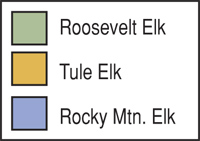 |
 |
Cervus elaphus nannodes
Also called valley elk or dwarf elk. "Tule" is a local name for either of two large bullrushes that grow in the southwestern United States and adjacent Mexico, and especially in central California where the tule elk is native.
DESCRIPTION The smallest American wapiti, lighter in color, and with small antlers that have arched beams and tines and tend to be palmate in larger specimens. Adult bulls average 550 pounds (250 kg), cows 410 pounds (185 kg).
HABITAT Open country and semi-desert.
DISTRIBUTION Only in California, where they originally occurred in great numbers in the broad, open valleys of the coastal and central parts of the state, where tules were the characteristic native plants. Now in several small herds (especially Cache Creek and Tupman) within the original range, and a larger transplanted population in the Owens Valley, which is outside its original range but considered indigenous for record-keeping purposes.
STATUS Tule elk did well until the 1849 gold rush in California, when their numbers crashed because of heavy market hunting and land development. Almost extinct by the late 1860s, when landowner Henry Miller provided the survivors with a refuge. These increased and served as the nucleus of the present healthy population. The tule elk has been out of danger since the late 1930s.
Surplus Owens Valley elk were culled through legal hunts held at various times from 1943 to 1964, after which the hunts were discontinued because of opposition from organized anti-hunters. Under the terms of the 1972 Behr bill in the California legislature, 490 elk are to be maintained in the Owens Valley, and no elk may be hunted until at least 2,000 exist in California. This level has been achieved and, beginning in 1988, permits have been available to California residents through drawings. In recent years, tule elk have also been available for hunting from private herds.
|





